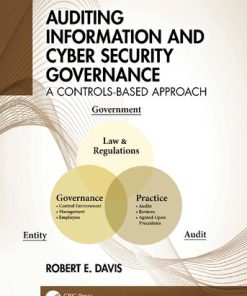Information Technology Auditing 4th Edition by James Hall 1133949886 9781133949886
$50.00 Original price was: $50.00.$25.00Current price is: $25.00.
Information Technology Auditing 4th Edition by James Hall- Ebook PDF Instant Download/Delivery: 1133949886, 9781133949886
Full download Information Technology Auditing 4th Edition after payment

Product details:
ISBN 10: 1133949886
ISBN 13: 9781133949886
Author: James A. Hall
Provide today’s learners with a solid understanding of how to audit accounting information systems with the innovative INFORMATION TECHNOLOGY AUDITING, 4E. New and expanded coverage of enterprise systems and fraud and fraud detection topics, such as continuous online auditing, help learners focus on the key topics they need for future success. Readers gain a strong background in traditional auditing, as well as a complete understanding of auditing today’s accounting information systems in the contemporary business world.
Important Notice: Media content referenced within the product description or the product text may not be available in the ebook version.
Information Technology Auditing 4th Table of contents:
Ch 1: Auditing and Internal Control
Ch 1: Learning Objectives
Ch 1: Introduction
Overview of Auditing
The Role of the Audit Committee
Financial Audit Components
Audit Risk
The IT Audit
Internal Control
Internal Control Objectives, Principles, and Models
Ch 1: Summary
Ch 1: Key Terms
Ch 1: Review Questions
Ch 1: Discussion Questions
Ch 1: Multiple-Choice Questions
Ch 1: Problems
Ch 2: Auditing IT Governance Controls
Ch 2: Learning Objectives
Ch 2: Introduction
Information Technology Governance
Structure of the Corporate IT Function
The Computer Center
Disaster Recovery Planning
Outsourcing the IT Function
Ch 2: Summary
Ch 2: Key Terms
Ch 2: Review Questions
Ch 2: Discussion Questions
Ch 2: Multiple-Choice Questions
Ch 2: Problems
Ch 3: Security Part I: Auditing Operating Systems and Networks
Ch 3: Learning Objectives
Ch 3: Introduction
Auditing Operating Systems
Auditing Networks
Auditing Electronic Data Interchange (EDI)
Auditing PC-Based Accounting Systems
Ch 3: Summary
Ch 3: Appendix
Ch 3: Key Terms
Ch 3: Review Questions
Ch 3: Discussion Questions
Ch 3: Multiple-Choice Questions
Ch 3: Problems
Ch 4: Security Part II: Auditing Database Systems
Ch 4: Learning Objectives
Ch 4: Introduction
Data Management Approaches
Key Elements of the Database Environment
Databases in a Distributed Environment
Controlling and Auditing Data Management Systems
Ch 4: Summary
Ch 4: Key Terms
Ch 4: Review Questions
Ch 4: Discussion Questions
Ch 4: Multiple-Choice Questions
Ch 4: Problems
Ch 5: Systems Development and Program Change Activities
Ch 5: Learning Objectives
Ch 5: Introduction
The Systems Development Process
Participants in Systems Development
Information Systems Acquisition
The Systems Development Life Cycle
Controlling and Auditing the SDLC
Ch 5: Summary
Ch 5: Key Terms
Ch 5: Review Questions
Ch 5: Discussion Questions
Ch 5: Multiple-Choice Questions
Ch 5: Problems
Ch 6: Transaction Processing and Financial Reporting Systems Overview
Ch 6: Learning Objectives
Ch 6: Introduction
An Overview of Transaction Processing
Accounting Records
Documentation Techniques
Computer-Based Accounting Systems
Data Coding Schemes
The General Ledger System
The Financial Reporting System
XBRL—Reengineering Financial Reporting
Controlling the FRS
Ch 6: Summary
Ch 6: Key Terms
Ch 6: Review Questions
Ch 6: Discussion Questions
Ch 6: Multiple-Choice Questions
Ch 6: Problems
Ch 7: Computer-Assisted Audit Tools and Techniques
Ch 7: Learning Objectives
Ch 7: Introduction
IT Application Controls
Testing Computer Application Controls
Computer-Aided Audit Tools and Techniques for Testing Controls
Ch 7: Summary
Ch 7: Key Terms
Ch 7: Review Questions
Ch 7: Discussion Questions
Ch 7: Multiple-Choice Questions
Ch 7: Problems
Ch 8: Data Structures and CAATTs for Data Extraction
Ch 8: Learning Objectives
Ch 8: Introduction
Data Structures
Designing Relational Databases
Embedded Audit Module
Generalized Audit Software
ACL Software
Ch 8: Summary
Ch 8: Appendix
Ch 8: Key Terms
Ch 8: Review Questions
Ch 8: Discussion Questions
Ch 8: Multiple-Choice Questions
Ch 8: Problems
Ch 9: Auditing the Revenue Cycle
Ch 9: Learning Objectives
Ch 9: Introduction
Revenue Cycle Activities and Technologies
Revenue Cycle Audit Objectives, Controls, and Tests of Controls
Substantive Tests of Revenue Cycle Accounts
Ch 9: Summary
Ch 9: Appendix
Ch 9: Key Terms
Ch 9: Review Questions
Ch 9: Discussion Questions
Ch 9: Multiple-Choice Questions
Ch 9: Problems
Ch 9: Internal Control Cases
Ch 9: ACL Assignments
Ch 10: Auditing the Expenditure Cycle
Ch 10: Learning Objectives
Ch 10: Introduction
Expenditure Cycle Activities and Technologies
Expenditure Cycle Audit Objectives, Controls, and Tests of Controls
Substantive Tests of Expenditure Cycle Accounts
Ch 10: Summary
Ch 10: Appendix
Ch 10: Key Terms
Ch 10: Review Questions
Ch 10: Discussion Questions
Ch 10: Multiple-Choice Questions
Ch 10: Problems
Ch 10: Internal Control Cases
Ch 10: ACL Assignments
Ch 11: Enterprise Resource Planning System
Ch 11: Learning Objectives
Ch 11: Introduction
What Is an ERP?
ERP System Configurations
Data Warehousing
Risks Associated with ERP Implementation
Implications for Internal Control and Auditing
Ch 11: Summary
Ch 11: Key Terms
Ch 11: Review Questions
Ch 11: Discussion Questions
Ch 11: Multiple-Choice Questions
Ch 11: Problems
Ch 12: Business Ethics, Fraud, and Fraud Detection
Ch 12: Learning Objectives
Ch 12: Introduction
Ethical Issues in Business
Fraud and Accountants
Fraud Schemes
Auditor’s Responsibility for Detecting Fraud
Fraud Detection Techniques
Ch 12: Summary
Ch 12: Key Terms
Ch 12: Review Questions
Ch 12: Discussion Questions
Ch 12: Multiple-Choice Questions
Ch 12: Problems
People also search for Information Technology Auditing 4th:
information systems auditing
information technology auditing
5 it audit objectives
3 information technology jobs
Tags:
James Hall,Information,Technology,Auditing
You may also like…
Business & Economics
Business & Economics - Accounting
Computers - Information Systems
Information Technology Project Management 9th Edition by Kathy Schwalbe 9781337101356 1337101354
Computers - Security
Computers - Information Systems
Computers - Computer Business & Culture
Business & Economics - Accounting
Computers - Networking
The Information A History a Theory a Flood 1st Edition by Gleick James ISBN 978-0007432523
History - World History











